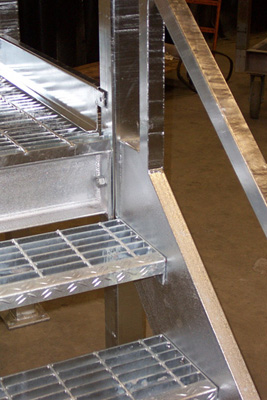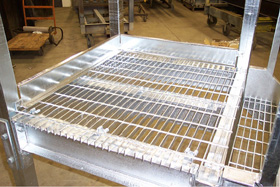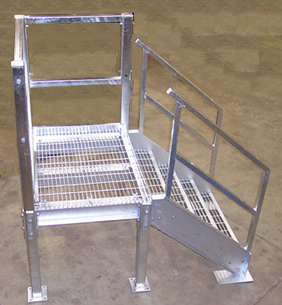|
HOT
DIPPED GALVANIZING
|
|
|
|
|
|
 |
|
|
|
NEW!
- Hot dipped galvanized finish |
|
|
|
|
|
|
|
The
steel products displayed on this thumbnail page are
now available
with a corrosion resistant finish applied to the steel
after fabrication.
Contact us for pricing! |
|
|
|
|
|
|
|
Hot
Dipped Galvanizing Corrosion Protection with Zinc
|
|
|
|
|
|
|
|
Steel
used to construct buildings, equipment, ornamental iron,
bolts,
nuts and other small parts requires corrosion protection.
The proven
effectiveness of zinc in controlling corrosion makes
it an ideal choice
for protecting structural steel. Hot dipped galvanizing
is generally the
most effective method of applying zinc to steel. |
|
|
|
|
|
|
|
Why
Galvanizing Works |
|
|
|
|
|
|
|
The
excellent corrosion resistance of hot dipped galvanized
steel is due
to the two fold nature of the coating. The zinc coating
provides barrier
and cathodic protection to the underlying steel surface. |
|
|
|
|
 |
|
|
|
|
|
During
the Galvanizing process, steel reacts with molten zinc
to form
a series of zinc-iron alloy layers which, together with
the outer zinc
layer, are metallurgically bonded to the steel surface.
The resulting
barrier coating has a very low corrosion rate (Figure
1) and, because
of the hard alloy layers, is highly resistant to mechanical
damage.
Galvanized steel is much less susceptible to coating
damage from
handling than is painted steel. |
|
|
|
|
|
As
the name implies, hot dipped galvanizing requires complete
immersion
of the work piece in molten zinc. This process ensures
a uniform coating
on all surfaces, even on those areas not normally accessible
to mechan-
ical applicators. |
|
|
|
|
 |
|
|
|
|
Zinc
corrodes preferentially to steel and provides cathodic
protection to
areas of bare steel (up to 1/4 inch wide) accidentally
exposed in service.
The sacrificial nature of zinc prevents the steel from
corroding adjacent
to the galvanized coating, thus preventing undercutting
and blistering of
the protective film. In comparison, exposed steel on
painted surfaces
will corrode immediately. The resulting rust occupies
several times the
volume of steel from which it was formed, causing the
lifting and
subsequent flaking of the adjacent paint film (Figure
2). |
|
|
|
CONTACT
US FOR PRICING!
|
|
|
|
|
|
|
|

